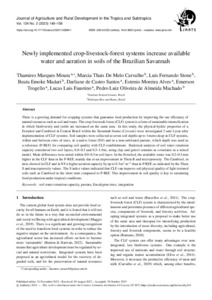| dc.date.accessioned | 2023-11-21T16:29:04Z | |
| dc.date.available | 2023-11-21T16:29:04Z | |
| dc.date.issued | 2023-11-21 | |
| dc.identifier | doi:10.17170/kobra-202311028941 | |
| dc.identifier.uri | http://hdl.handle.net/123456789/15201 | |
| dc.language.iso | eng | |
| dc.rights | Namensnennung 4.0 International | * |
| dc.rights.uri | http://creativecommons.org/licenses/by/4.0/ | * |
| dc.subject | soil water retention capacity | eng |
| dc.subject | pasture | eng |
| dc.subject | Eucalyptus trees | eng |
| dc.subject | Integration | eng |
| dc.subject.ddc | 500 | |
| dc.subject.ddc | 630 | |
| dc.title | Newly implemented crop-livestock-forest systems increase available water and aeration in soils of the Brazilian Savannah | eng |
| dc.type | Aufsatz | |
| dcterms.abstract | There is a growing demand for cropping systems that guarantee food production by improving the use efficiency of natural resources such as soil and water. The crop-livestock-forest (CLF) system is a form of sustainable intensification in which biodiversity and yields are increased on the same area. In this study, the physical-hydric properties of a Ferralsol and Cambisol in Central Brazil within the Savannah biome (Cerrado) were investigated 2 and 1 year after implementation of CLF systems. Soil samples were collected at seven soil depths up to 1 meter deep in CLF systems, within and between rows of trees, in a native forest (NF) and in a non-cultivated pasture, which was used as a reference (P-REF) for comparing soil quality with CLF establishment. Statistical analysis of soil water retention capacity considered two soil layers, 0.0-0.3 and 0.3-1.0 m, using clay and gravel contents as covariates in a mixed model. Main differences were noted within 0.0-0.3 m soil layer. In the Ferralsol, the available water was 0.2-0.3 mm higher in the CLF than in the P-REF, mainly due to an improvement in Theta R and microporosity. The Cambisol, in turn, showed in CLF and in NF a higher aeration capacity by up to 0.3 m3 m-3 than in P-REF, as indicated by the Theta S and macroporosity values. The S index values showed that CLF can improve soil physical quality of light textured soils such as Cambisol in the short term compared to P-REF. This improvement in soil quality is key to sustaining food production under tropical conditions. | eng |
| dcterms.accessRights | open access | |
| dcterms.creator | Marques Moura, Thamires | |
| dcterms.creator | Carvalho, Márcia Thaís De Melo | |
| dcterms.creator | Stone, Luis Fernando | |
| dcterms.creator | Madari, Beata Emoke | |
| dcterms.creator | Santos, Darliane de Castro | |
| dcterms.creator | Moreira Alves, Estenio | |
| dcterms.creator | Trogello, Emerson | |
| dcterms.creator | Faustino, Lucas Luís | |
| dcterms.creator | Machado, Pedro Luiz Oliveira de Almeida | |
| dc.subject.swd | Brasilien | ger |
| dc.subject.swd | Savanne | ger |
| dc.subject.swd | Wasserrücklage | ger |
| dc.subject.swd | Boden | ger |
| dc.subject.swd | Beweidung | ger |
| dc.subject.swd | Eukalyptus | ger |
| dc.subject.swd | Latosol | ger |
| dc.type.version | publishedVersion | |
| dcterms.source.identifier | eissn:2363-6033 | |
| dcterms.source.issue | No. 2 | |
| dcterms.source.journal | Journal of Agriculture and Rural Development in the Tropics and Subtropics (JARTS) | eng |
| dcterms.source.pageinfo | 149-158 | |
| dcterms.source.volume | Vol. 124 | |
| kup.iskup | false | |


